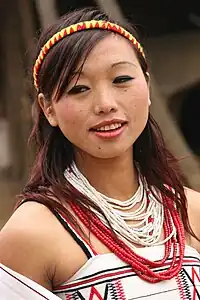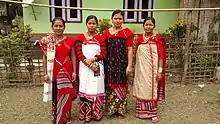 Mising women in traditional dress | |
| Total population | |
|---|---|
| 687,836 (2011 census) | |
| Regions with significant populations | |
| India | |
| Assam | 680,424+[1] |
| Arunachal Pradesh | 7,412+[1] |
| Languages | |
| Mising • Assamese | |
| Religion | |
| Ekasarana Dharma, Christianity, Donyi-Polo | |
| Related ethnic groups | |
| Nyishi, Adi, Apatani, Galo, Tagin, Tibetans | |
| Part of a series on the |
| Culture of Assam |
|---|
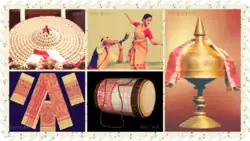 |
The Mising people are a Sino-Tibetan indigenous ethnic group inhabiting the Northeast Indian states of Assam and Arunachal Pradesh. They are part of Tani group of people of Northeast India.
Etymology
Mising is an endonym and literally means "man of the soil." Miri, on the other hand, is an exonym commonly applied by plains Assamese people. There is still much scholarly debate on the origins of this term: some colonial scholars argued 'miri' referred to their status as intermediaries between plains peoples in the Brahmaputra Valley and hill tribes to the north, while others such as Grierson (1909) thought it meant "gentleman," while Crooks interpreted it as "hill man." More recent scholarship associated miri with religious functionaries in some Tani hill-tribes. According to this view, when the Misings migrated to the plains they were identified as coming from the Miri pahar ('Miri hills'), whose feats of magic would have been well-known back then, and the name stuck.
History
The Misings belong to the greater group of Tani people, who belong to a Sino-Tibetan linguistic group, inhabiting parts of the Indian states of Assam and Arunachal Pradesh and Tibet Autonomous Region of China. Tibetans refers the Tani people as the Lhobhas (Tibetan: ལྷོ་པ།); lho means south and bha means people, Lhobhas means "southerners" i.e. the people who reside in South Tibet and the area inhabited by them in ancient Tibetan text were called Lhoyü which is now the Indian state of Arunachal Pradesh and some parts of Tibet.
In older times, Mising and other Tani people traded swords and other metals to Tibetans in exchange for meat and wool and used Tibetan language for written communication as they had no written language of their own.[5]
The earliest mention of the Misings comes from the Ahom Buranjis in the early 17th century, when the Misings were still independent hill-tribes to the north of the Brahmaputra valley. In 1615, the Misings raided Ahom territory and the force sent to subdue them failed. In 1655, the Misings launched another raid which resulted in a successful counterraid by Ahom forces during which the Misings were subjugated. They agreed to pay an annual tribute to the Ahoms and gave 12 men to the Ahoms for the two they burnt. Afterwards many Misings were given high positions in Ahom administration, evidence of their greater cultural contact with the Assamese compared with other hill-tribes.[6]
The Mising or Miri karnis (archers) who were employed in the Ahom army rendered great service in suppressing the Nagas who were obstructing the supply of food provisions, to the Ahom army during the Rudra Singha's invasion to Kachari kingdom. The Misings also served in the Jaintia expedition of Rudra Singha (1707–1708). The Misings living near about Sadiya gave trouble to the Ahom government during the 17th century, but became submissive and peaceful by the reign of Rudra Singha, which they remained till the end of Ahom rule. Even during the Moamoria rebellion, when most hill tribes turned rebellious towards Ahom government, the Mising or Miris remained loyal. [7]
Migration
There is no written history of Misings about their migration from the Himalayas to the plains of Assam but history was passed down orally in the form of folk songs and stories by the ancestors from generation to generation and is still prevalent among their society. Although, they were initially hill dwellers, they later migrated to the plains and started living on the banks of rivers of Assam. The reason for this change of habitat is not known, but one theory says that the Misings presently living in plains of Assam were not one single tribe, but it evolved into one when many tribes from various Tani tribes of Arunachal Pradesh migrated to the plains of Assam. This explains the presence of many Mising clans with different Mising dialects as well as different levels of development. As per historians, the Misings came down to the plains in two groups, the Barogam and the Dohgam.[8] Other theories stated that the Misings in hill regions of the Subansiri-Siang region were subordinate to the Abors and so migrated to the plains to escape their plight. Mising folktales speak of an ambush of Burmese soldiers by Misings on the Brahmaputra, implying Misings were established in Assam before the Burmese invasions of 1817. However, during the early British period Misings continued to move down to the plains but even they would continue to face raids from their former Abor overlords. British administrators also tried to force many Misings back to the hills into their old subordinate status. However, when the British pacified the hill tribes, the Misings were able to live in peace in the plains.[6]
In 1924, educated Mising tribes formed the Mising Bane Kebang (Great Assembly of the Mising), now an important Mising organization.
Autonomy movement
The Misings currently has some state autonomy under the Mising Autonomous Council (MAC), which was formed in 1995 following violent clashes in the early 90s for greater autonomy. MAC includes 40 constituencies in eight upper Assam districts comprising core areas and satellite areas. Executive councillor (EC) from 36 constituency are elected democratically while 4 other members are represented by the ruling government of Assam. Tensions exist between the Mising tribe and other communities regarding the inclusion of a few Non-Mising villages in MAC. Although no violence occurred between Misings and non-Misings, some non-Mising unions clashed with the police. The MAC area constitutes more than 60% ST population and other communities are a minority. Most of the Misings today reside in the districts of Dhemaji and Lakhimpur, bordering Arunachal Pradesh, while a significant number is present in the Majuli district as well. Since 1983, Mising organizations have been demanding Sixth Schedule status under the Constitution of India. Various Mising nationalist organizations have been formed, like Takam Mising Porin Kébang (Mising Students' Union) and Mising Bahne Kebang (Mising Council) after inclusion of education in Mising areas.
Population
According to the census of India conducted in 2011, the population of Mising in Assam is approximately 7 lakhs. They live in 10 districts of Assam: Dhemaji, Lakhimpur, Sonitpur, Tinsukia, Dibrugarh, Sivasagar, Majuli, Charaideo, Jorhat and Golaghat, and in three districts of Arunachal Pradesh: East Siang district, Lower Dibang Valley, and Lohit. The most prominent Mising villages in Arunachal Pradesh include Oyan, Namsing, of East Siang district. In Lohit District's Namsai, a good number of Mising are found, especially in the areas around Silatoo Mising village.[1]
Culture
Music and dance
The Misings have a variety of different types of folk songs.
- Ahbang – It is a verse of hymn of praise and worship of gods and goddesses. Ahbang is sung by the Mibu (priest) at rituals. There is also community Ahbangs generally used in Pobua or Porag, a ritual festival, praying for better crops, health and happiness.
- Kaban – It is one of the oldest forms of Mising folk songs. It is lamentational music.
- Tebo Tekang – It is a romantic lyric.
- Siuhung Nitom – It is a melancholic song.
- Bini – These are lullabies sung either at home or in the field, taking babies to places of work. The baby is tied to the back of the mother or the young babysitter.
- Midang Nitom – This is usually sung at the time of ushering in a bride to her new home, often in order to tease her.
- Oi Nitom – It is the most popular form of Mising folk song, sung by Mising youths when they are working or moving about the fields, woods, etc. It is a part of the Mising Soman (dance).
There are many types of Mising dances, and each has its particular rules. Gumrag is performed five times in circles. Drums and cymbals are the usual musical instruments for the dances.
- Mibu Dagnam – It is a dance performed mostly during Po:rag, the harvesting festival, observed in the Murong, the community hall of the Misings. The priest sings the Ahbang while performing this ritual dance.
- Selloi – Song and dance often performed for fun with the accompaniment of drums or cymbals. It marks the beginning of the influx of the Mising people from hills to plains of Assam.
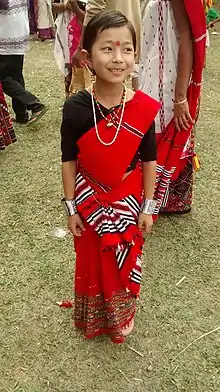 A Mising girl in traditional dress
A Mising girl in traditional dress
- Lereli – Occasionally, all sections of Mising people indulge in singing and dancing lereli in sheer fun and merriment, especially at meeting old friends.
- Ejug Tapung Sohman – This is a very ancient form of dance performed to the accompaniment of ejug tapung, a wind instrument resembling the snake charmer's been.
- Gumrag Sohman (Gumrag Paksong) – This dance is performed on the occasion of Ali-Aye-Ligang and in Mising Bihu.
- Lotta Sohman – This dance is performed on any occasion, as an expression of joy or community celebration.
Clothing
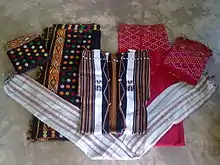
The traditional craft of weaving is a very important aspect of Mising culture.[9] It is an exclusive preserve of the Mising woman, who starts her training in the craft even before she reaches her teens. Men wear cotton jackets (Mibu Galuk), light cotton towels, endi shawls, thick loin cloths, and, occasionally, even shirtings. Women wear a variety of clothes. The ege is a lower garment, comprising a sheet of cotton. Above this may be draped a ri:bi or Gaseng, both cotton sheets used to cover the ege and a blouse. However, while the ri:bi has narrow stripes, the gaseng has broad stripes of contrastive colours. Instead may be worn a Gero: a sheet, usually off-white, wrapped round the waist to cover the lower part of the body, or round the chest to cover the body down to the knees or so, or a seleng gasor: a light cotton sheet, worn occasionally instead of a ri:bi or a gaseng. Other forms of clothing include the riya, a long, comparatively narrow, sheet, wrapped, a bit tightly, round the chest. Married women will wear the segrek, a loose piece of cloth, wrapped round the waist to cover the ege down to the knees. Other accessories include a po:tub: a scarf used to protect the head, and nisek: a piece of cloth to carry a baby with.
Before yarn was available in the market, Misings used to grow cotton and obtain cotton yarn by spinning. The use of endi yarn, obtained from worms fed on leaves of castor-oil plants, was once common amongst them. However, they have learnt the use of muga (silk obtained from silkworms fed on a kind of tall tree, called som in Assamese) and of paat (silk obtained from silkworms fed mulberry leaves) from neighbouring indigenous communities in the valley. Mising women weave cloths, using muga and paat silk, very sparingly.
The Mising also has a blanket called gadu, fluffy on one side, and woven on a traditional loin loom. The warp consists of cotton spun into thick and strong yarn, and the weft of cotton turned into soft yarn and cut into small pieces for insertion, piece by piece, to form the fluff.
Religion
The Misings follow their own traditions, called Donyi Polo, the Sun and the Moon God. They are still mainly animists and adopted some aspects of Vaishnavism after the Bhakti movement that was started by Sankardev, (1449–1568 AD), the saint-poet of Assam.
Their creation myth is as follows: first was Sedi babu, the Supreme Being. He created Melo-Nane, and together they created Ditem (the Earth), Adi-Ditem (the mountain), Nei-Negan (green-leafed trees), Rukji-Merang (Acalypha indica and insects) and Peyi-Pettang (birds and animals). They also created the sun (Donyi) and Polo (the moon), the wind (echar), water (aasi)(Mising), fire (eme)(Mising), and other aspects of the universe. Sedi then created Diling, whose descendant Pedong gave birth to Dopang, Domi and Doshing. Domi's son, Miniyong, was the ancestor of the Mishings.
They believe in different supernatural beings haunting the earth, usually unseen. These supernatural beings fall into four categories: uyu or ui – usually malevolent spirits inhabiting the waters, the woods, the skies, etc. capable of causing great harm including physical devastation, urom po-sum – hovering spirits of the dead, who may cause illness or other adverse conditions, guhmeen-sohing – benevolent ancestral spirits, and epom-yapom – spirits inhabiting tall, big trees, who are generally not very harmful, but who may abduct human beings occasionally, cause some physical or mental impairment and release them later. Barring the epom-yapom, all the supernatural beings supposedly need to be propitiated with sacrificial offerings (usually domestic fowl), both periodically and on specific occasions of illness, disaster, etc. Even the benevolent guardian spirits are propitiated from time to time for the all-round wellbeing of a household. The god of thunder is propitiated from time to time, and although not worshipped or propitiated, the Sun (who they call Ane-Donyi ‘Mother Sun’) and the Moon (who they call Abu Polo ‘Father Moon’) are invoked on all auspicious occasions.
The leader of their animistic faith is called a mibu (also called miri earlier), their priest or medicine man, who is supposed to be born with special powers of communion with supernatural beings. While mibus are on their way out amongst the Misings owing to the introduction of modern education and healthcare amongst them, propitiation of supernatural beings continue to mark their religious life.
In addition, they have embraced in the valley some kind of a monotheistic Hinduism as passed on to them by one of the sects of the Vaishnavism of Sankardeva.
Festivals
Mising people celebrate various festivals, though, the two chief traditional festivals of the Misings are the Ali-Ayé-Lígang, and the Po:rag, both connected with their agricultural cycle.
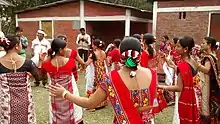
Ali-Ayé-Lígang is a festival marking the beginning of the sowing season, and marks the start of a new agricultural calendar. Ali-Ayé means seeds in a row, and Lígang means sowing of seeds. Ali-Ayé-Lígang starts on the second Wednesday of February, considered an auspicious day, and lasts for five days. Ali-Ayé-Lígang is a five-day festival. The celebrations begin with the heads of families sowing ceremonially rice paddy seeds in a corner of their respective rice fields in the morning hours and praying for crop abundance. Young men and women participate in the occasion by singing and dancing at night in the courtyard of every household in the villages to the accompaniment of drums, cymbals, and a gong. The gong is not used on any festive occasion other than the Ali-Ayé Lígang. Similarly, the drums have specific beats for this festival. The troupe accepts from each household offers of rice beer and fowls. After the singing and dancing in this way is over, the youths hold a feast on the third day.
Po:rag is the post-harvest festival of the Misings. Harvesting of paddy rice in autumn is usually observed now sometime in early winter or early spring. But there was a time when a harvest in summer was very common amongst them and so, Po:rag was celebrated earlier in the months of August or September also.
Another occasion called Dobur is an animistic rite performed occasionally by the village community by sacrificing a sow and some hens for different purposes. The form of observance of Dobur varies according to the purpose. In the most common form, the younger male members of a village beat the walls of every house in the village from one end to the other with big sticks to drive away the "ghosts and goblins hiding" and hold a feast there.
Some of the features of Bihu dances, boys and girls dancing together for instance, may have been borrowed from the Misings.
Notable people
- Indira Miri, Indian educationist
- Shakuntala Doley Gamlin, IAS officer
- Ganesh Kutum, politician
- Naba Kumar Doley, politician
- Tabu Taid, Indian author
- Jadav Payeng, Forest Man of India
- Bhubon Pegu, politician
- Lalit Kumar Doley, Indian politician
- Mrinal Miri, Indian philosopher
- Bharat Narah, politician
- Rajib Lochan Pegu, politician
- Tarun Chandra Pamegam, writer
- Ranoj Pegu, Present Education Minister Of Assam State
See also
Notes
- 1 2 3 "A-11 Individual Scheduled Tribe Primary Census Abstract Data and its Appendix". www.censusindia.gov.in. Office of the Registrar General & Census Commissioner, India. Retrieved 2017-11-03.
- ↑ "639 Identifier Documentation: aho – ISO 639-3". SIL International (formerly known as the Summer Institute of Linguistics). SIL International. Retrieved 2019-06-29.
Ahom [aho]
- ↑ "Population by Religious Communities". Census India – 2001. Ministry of Home Affairs, Government of India. Retrieved 2019-07-01.
Census Data Finder/C Series/Population by Religious Communities
- ↑ "Population by religion community – 2011". Census of India, 2011. The Registrar General & Census Commissioner, India. Archived from the original on 25 August 2015.
2011census/C-01/DDW00C-01 MDDS.XLS
- ↑ Xiaoming Zhang (2004). China's Tibet. 五洲传播出版社. p. 23. ISBN 7-5085-0608-1.
- 1 2 Bhandari, J. S. (1984). "Ethnohistory, Ethnic Identity and Contemporary Mishing Society". Indian Anthropologist. 14 (2): 79–103. ISSN 0970-0927. JSTOR 41919494.
- ↑ (Devi 1968:163–165)
- ↑ Das, Juthika, The mishing culture of assam: A socio philosophical study,p. 44
- ↑ Farida, Syeda (2019-04-22). "#WhoMadeMyClothes". The Hindu. ISSN 0971-751X. Retrieved 2019-04-24.
References
- Devi, Lakshmi (1968). Ahom-tribal Relations: A Political Study.
